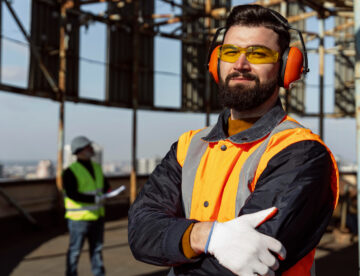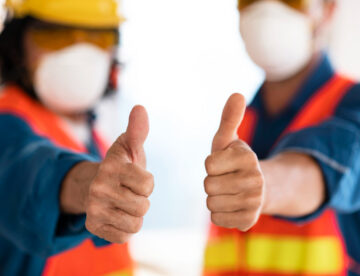
Research suggests that the average British construction worker consumes more than 4000 calories a day. That’s 1500 calories above the recommended daily intake for men and 2000 more than what’s recommended for women.
While the daily toll of physical labour means construction workers probably do need more fuel than the average person, the problem is that they’re often choosing unhealthy fast-food options which do not provide the best energy boost and have long-term health implications. Find out more in this week’s blog which includes some healthy alternatives for your key fuelling up times – breakfast and lunch.

With tools and equipment in almost constant use, a construction site is generally a noisy environment.
Aside from the potential for this to cause nuisance to neighbouring communities, frequent exposure to raised noise levels can have serious consequences for workers, causing problems like tinnitus (a sensation of ringing in the ears) and hearing loss.
Find out more, including how to protect yourself from these risks in this week’s blog.

Schools and colleges have broken up and, aside from the unpredictable weather, this means lots of young people will now be nervously waiting for their exam results and preparing for the next stage of their life.
While some will know exactly what they want to do, others might still be considering the options. For anyone considering a career in construction but not knowing where to start, we’ve got three steps you could follow in this week’s blog.

Following repeated calls from leaders within the construction industry, the Home Office has finally announced it is easing visa restrictions for brickies, roofers and chippies from overseas by adding them to the UK’s Shortage Occupation List (SOL).
This list is designed to help sectors where employers are struggling to fill vacancies and the move to include more construction trades has been welcomed by the Construction Leadership Council as a solution to addressing immediate skills shortages in the UK. Find out more in this week’s quick-read blog.

Last Friday we held our first summer BBQ at Sheriff Construction and raised £2612 for a wonderful charity, Macmillan Cancer Support!
Around 80 people joined us, including from our roofing, brickwork and office teams, all of which enjoyed some great food and drinks while giving generously to this worthy cause. Find out more and relive the evening in this week’s blog.

Today marks the 75th anniversary of the NHS, known worldwide as one of the first and best healthcare systems to be universally available and free at the point of delivery.
Unfortunately, while its principles are unshaken, the NHS today is under pressure due to several issues – staff shortages, backlogs from Covid and industrial action to name a few.
Is there anything the construction sector can do to help? The answer actually is ‘yes’. Construction is high-risk industry for both injuries and health issues, but focusing on preventative measures can reduce those risks (consequently reducing some of the pressure on the NHS). Read on to find out more.

Earlier this month, more than 100 UK businesses joined forces with the UK Green Building Council (UKGBC) in calling upon the Government to urgently reform the planning system to tackle climate change alongside the UK’s deepening housing crisis.
In their letter to government, the coalition is asking for reforms to the planning system that would bring it in line with the Climate Change and Environment Acts and says the Levelling Up and Regeneration Bill (currently going through Parliament) could also be a crucial opportunity to align planning decisions with the nation’s net zero emissions target. Find out more in today’s blog.

Today (20th June) is World Refugee Day, a moment when people are invited to not only consider the plight and dismal conditions faced by millions of refugees around the world, but also to celebrate the strength and courage of people who have been forced to flee their home countries to escape disaster, conflict or persecution.
Offering the tagline ‘Hope away from Home. A world where refugees are always included’, this year’s theme made us wonder what the inclusion of refugees has meant for the UK in general and how it might work within industries like construction. Read this week’s blog to find out more.

Even though some people may be out off by rising energy prices and interest rates, home ownership is still very common, with many people viewing it as both a security blanket for themselves and their families and a lucrative investment opportunity.
When searching for the ideal residence, people tend to look for traditional must-haves like outdoor space, the size of the home, parking and local amenities. However, with new ideas and technologies constantly changing the way our houses are designed and fitted out, we wondered what might become the must-haves of the future. Read on for a few thoughts…

In recent years, drone technology has made it far easier to view aerial images of the UK’s urban landscape. But, while our towns and cities are hugely diverse in architectural character, looking down from above they are often very similar, with a common sight being a mass of black, brown and grey roofs.
However, there is a trend which has started to add patches of colour to the aerial perspective – green roofing! In this week’s blog, we’ll explain more about what a green roof is and look at six reasons why this is proving to be a great option for our buildings.
